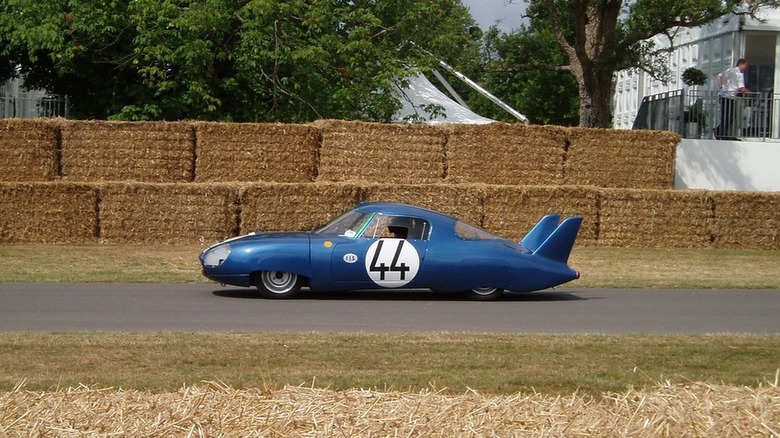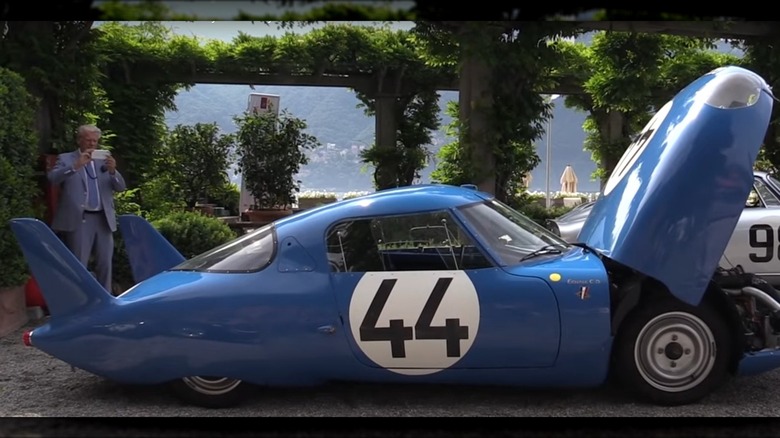The 1964 Panhard LM64 Didn't Win Le Mans But Its Legacy Is Even More Impressive
By most accounts, Le Mans is the world's most prestigious sports car race. Held in Le Mans, France, every year since 1923, it's certainly the oldest active endurance race. Roughly 60 of the world's fastest cars race for 24 hours along the serpentine 8.5-mile Circuit de la Sarthe road course.
It began as a way for car manufacturers to show off how tough their vehicles were in direct comparison to their respective competition, but over the last 100 years has morphed into a "last car standing" battle royale between the world's best professional racing teams where speeds routinely surpass 200 mph. It tests the stamina of both car and drivers, and bragging rights for the winner are stratospheric.
But back in the 1960s, the race was very different. Speed wasn't the only focal point. The second most valuable award, the Index of Thermal Efficiency (ITE), was a big deal. Also called the Index of Efficiency (or IOE), it focuses on a car's speed, weight, fuel consumption, and gas mileage at racing speeds. It also looked at the vehicle's drag coefficient (Cd), an aerodynamic measurement of how a car slices through the air.
So what business does a pair of diminutive, mild-mannered 848 cc 78 hp — gorgeously designed and supercharged – Panhard CD LM64s have racing on a track with Ferrari, Porsche, and Ford GT40s? Funny you should ask.
[Featured image by Balano via Wikimedia Commons | Cropped and scaled | CC BY Public Domain]
An aerodynamic racer with good gas mileage
In 1959, Le Mans began giving awards for the Index of Thermal Efficiency (ITE). Some believe it may have been partly due to the Suez Canal Crisis that occurred a few years earlier and highlighted just how easily the flow of petroleum could be disrupted to Western Europe.
During that inaugural ITE season, the winner was a Panhard from Deutsch-Bonnet (branded as DB), sporting a 744 cc engine and posting an MPG of 25.69. In business for almost 25 years, the company was helmed by French automobile designer Charles Deutsch and engineer René Bonnet. It was widely known for building super lightweight, ultra-aerodynamic sports cars. The following year, they achieved the best gas mileage (37.58 mpg) with another Panhard, but a Lotus Elite — with a faster, bigger 1,216 cc engine — won the ITE award.
Unfortunately, Deutsch and Bonnet disagreed on how future cars should be designed. Not only did they clash on engine types — Deutsch wanted to stick with Panhards, but Bonnet wanted to go with Renault — they couldn't agree on whether the car should be front-engined with front-wheel-drive or go to a mid-engine placement.
Deutsch and Bonnet went their separate ways in 1961. Bonnet went to Renault, while Deutsch moved to Panhard. Deutsch designed his first Panhard (the Dyna) in 1962, but a car designed by Bonnet would win the ITE in 1963 with a 1,108 cc engine and posting an MPG of 22.63.
This car was slippery even when it wasn't wet
So, in '64, using the Panhard chassis as a base, Deutsch and his team went about creating a pair of bespoke racers (LM64-01 and LM64-02) powered by an 848 cc engine with the intention of winning the ITE trophy. Everything was designed to eliminate drag.
The most noticeable design choice was the sleek, "slippery," elongated, almost dolphin-like body, with spats enclosing all four wheels. The bellies of each car were fitted with a wholly encased underbody that helped generate downforce and glue the car to the road, a concept later called ground effect and not widely used for a few more years. The high-reaching dual fins (very dolphin-like indeed) on the back helped cut a clean line through the wind. Front headlights on the rounded bulbous nose were also fully enclosed.
Deutsch tested the airflow of the LM64 body at the Gustave Eiffel Aerodynamic Laboratory. If Gustave Eiffel sounds familiar, he's the guy who built the famous tower. Interestingly enough, he also made the lab in 1912, and since it's still operating, it is considered the world's oldest aerodynamic test lab.
The 848 cc engine wasn't powerful under Le Mans regulations, so they attached a Sferma supercharger, which boosted it to an "official" 1,187cc, allowing them to run in the under 1,200cc class.
A hard end for the Panhard
Both cars entered the '64 Le Mans, but neither car finished. Ferraris took the top three spots (and five of the top six), and Porsche took five of the next six. Rene Bonnet's Aerodjet came in 23rd (after starting in 53rd), completing 260 laps. The Panhard CD LM64-01 ran for 13 hours (124 laps) before gearbox problems halted its race, while the LM64-02 ran for 10 hours (77 laps) before its engine failed.
Neither car raced again until both took part in the 2004 Le Mans Classic during the 40th anniversary of their only race. Deutsch went on to create more cars, and the passenger version of the Panhard was built until 1967 when Panhard was taken over and merged into Citroen. Deutsch would later work on the equally iconic Porsche 917 race car, which had a similarly long tail and low drag coefficient.
Today, the Panhard CD LM64 is regarded as one of the most recognizable prototypes ever to race at Le Mans and one of the most important because it is, without exception, the most aerodynamic car of all time. With a coefficient of drag of just 0.12, it's sleeker than every automobile ever made, including the Volkswagen XL1 (Cd 0.186), McLaren Speedtail (Cd 0.278), every Tesla model, and even built-for-speed racers like the Mk1 Ford GT40 (0.35).
It's ironic then that French automobile designer Charles Deutsch, whose initials (CD) are in the car's name, also stands for drag coefficient (Cd).

